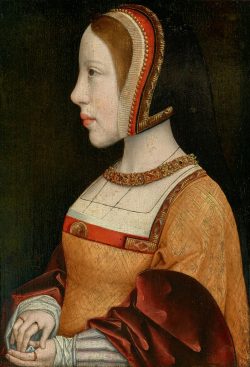It was a dazzling affair for Princess Isabella. She was the sister of the Holy Roman Emperor, Charles V, thus the Spanish name. In her veins flowed the finest blood in Europe, and she was the daughter of the famous Ferdinand and Isabella, her namesake. Now, added to her Hapsburg titles, she was to be wed to the King of all Scandinavia, embracing the three kingdoms of Sweden, Norway, and Denmark. Her new husband, Emperor of all Scandinavia, was His Majesty Christian II. The vast country of Scandinavia would all be under her scepter, and with her husband she would rule this vast shield of northern Europe.
Isabella’s bridegroom, Christian II, was a magnificent king, skilled in the art of war, but also an expert in agriculture, industry, and commerce. He was now 37 years old, with both youthful strength and mature experience, he still retained the flush of youth on his handsome face. A grand and royal wedding was prepared for her in Copenhagen, her new home. Even the most ambitious girl’s heart would flutter at such a dazzling wedding.
As she arrived at the palace in Copenhagen, Denmark for the royal wedding, a splendid array awaited her. In her train was a chest of gold containing 300,000 flourins, her wedding dower. When she entered the grand hall, trumpets blared, men-at-arms stood at attention, and all rose. Even the minstrels and dancers ceased their tumbling and turned their eyes to look upon their new monarch. Isabella was only 15 years old.

The people of Scandinavia honored large and brawny muscles, blond hair, and strong features. Their new monarch was a thin, pale girl with dark hair and a distinctly Spanish appearance. In spite of the contrast between the young, thin, pale bride and the middle-aged, broad-shouldered, ruddy groom, the wedding went on grandly. The Scandinavian people paid their respects to their new queen. The minstrels went on playing, the royal dinner was prepared, and the grand evening of festivities commenced.
At this time in the history of Scandinavia, the Roman Catholic Church still held sway, but the winds of Reform were sweeping through Europe. It was 1518, and the year before, an unknown German monk named Martin Luther had nailed 95 theses to the door of a church in the city of Wittenberg in the German state of Saxony.
Already, the writings of Luther had filtered into Denmark, and Copenhagen was shaken by the simple truth of Luther’s propositions. But Christian II still held fast to the faith of his ancestors, and a priest was present at the wedding to say mass. Unfortunately for the young and tender bride, the priest, impressed with a sense of his own importance, had prepared a lengthy sermon on the significance of this union. While he was delivering what the historian of the Reformation, J.H. Merle D’Aubigne calls “an interminable discourse,” the young bride, the object of everyone’s attention, suddenly turned deathly pale and fainted.
Perhaps Isabella was overcome by the brilliance of the festivities. Perhaps her frail body could no longer tolerate the attention of the crowd. Perhaps she simply locked her knees too long. One of her ladies in waiting caught the fifteen-year-old bride, and she was carried to an adjoining room.
This young princess, now queen of Scandinavia, would have a much greater impact upon Europe than her frail form would suggest. This tender, thin, black-eyed Spanish girl would transform, by her example, the future of three kingdoms, and her name would soon be known throughout Protestant Europe. For early in her reign, this young queen embraced the doctrines of the Word of God.
Ponder for a moment the implications of the conversion of Isabella. Her father and mother were Ferdinand and Isabella of Spain – the pair that instituted the bloody Spanish Inquisition, that inundated the streets of Madrid and Seville in the blood of martyrs. Her brother was Charles V, Holy Roman Emperor, the man who declared Martin Luther an outlaw and public enemy at the Diet of Worms. She was also related to Catherine of Aragon of England, and thus the infamous Bloody Mary. For this young girl to take a stand on the side of the Reformed faith was a marvelous thing indeed.
Isabella’s married life was not a happy one. In spite of his fine name, Christian II was anything but. D’Aubigne says of Christian II:
“It must be confessed that self-interest was the mainspring of his enterprises. A friend to knowledge, to the sciences, to agriculture, commerce, and industry, he nevertheless took after his barbarian ancestors. He was cruel, and would go headlong to extremities. This man of the North always retained the fierce temper of a savage, nor did he ever learn to subdue the evil dispositions which actuated him. In his fits of violence, he had no regard for age, for virtue, or for greatness.
Such was the man Isabella, now an earnest Christian, had to live with. Like Queen Esther in the court of Ahasuerus, Queen Isabella had to try to please a wicked husband who was absolute ruler over both her and the realm. Christian II was known for his dissolute living, and he kept mistresses at court, which was a constant grief to his pure and devoted young wife. But, as was the case with Esther in a similar situation, God had brought Isabella into the kingdom for “such a time as this.”
Soon, she began to quietly give aid to the persecuted evangelical preachers of northern Europe. Her piety was known throughout Sweden, Denmark, and Norway, and although war was brewing between these kingdoms, and the Swedes were valiantly rising up against the oppression of Danish rule, even the Swedes respected their young and pious queen.
Isabella did not live a long life. Her frail body could not support her long in this world, but she lived to accomplish her mission. Her piety did more for her realm than all the warlike vigor of her dissolute husband. She prayed for the conversion of her realm. She gave money to needy pastors. She interceded with her husband on behalf of the persecuted believers of Scandinavia. She became a warm friend of Martin Luther and corresponded with him often. Once, her staunchly Roman Catholic family, including the Emperor Charles V and another brother, Ferdinand, the archduke of the Austrian and Hungarian realms, threatened to disown her if she persisted in her heresy.
The noble young lady replied, “Even if you disown me, I will not on that account disown the Word of God.” The girl that had fainted at her own wedding would not faint now. Truly, God’s grace is sufficient and His strength is made perfect in our weakness.
Isabella died at the age of 23. Her family, in their superstition and fear, ordered that a priest give her extreme unction, but by that time, the young queen was unconscious. All Europe knew that the Romish ceremony was done against her will and without her consent. Her life had a wide and deep impact beyond her tender years. She impacted the future of Denmark, Sweden, Norway, the Netherlands, and even the German states. D’Aubigne says of her life, “The faith of the dying queen was everywhere known and gladdened the friends of the Gospel.”
Martin Luther commented, perhaps with a smile, upon the death of his young friend, “Christ wished for once to have a queen in heaven.”
Bibliography
History of the Reformation by J. H. Merle D’Aubigne




